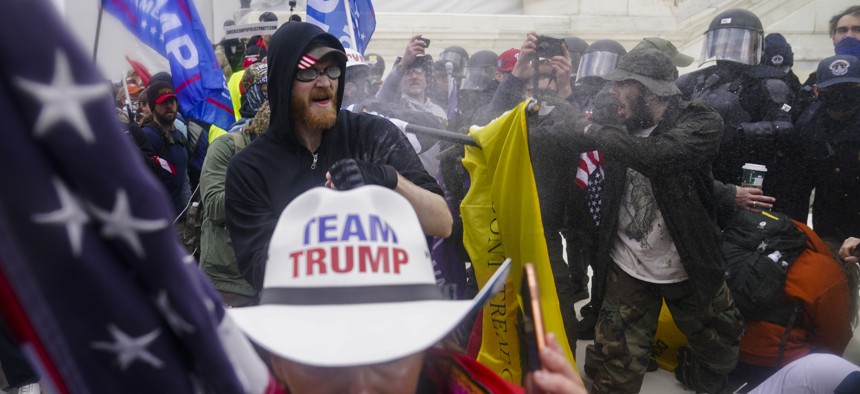
Trump supporters try to break through a police barrier at the Capitol in Washington on Jan. 6. AP Photo
Congress Launches Investigations into Capitol Police Following Siege
Two Senate committees add an inquest to the House inquiry announced on Thursday.
Two Senate committees on Friday announced a joint investigation into the security failures that allowed an angry mob of Trump supporters to storm the U.S. Capitol on Wednesday, interrupting the certification of the presidential election results and leading to the deaths of five people.
The probe will by led by the bipartisan leaders of the Rules and Administration Committee and the Homeland Security and Governmental Affairs Committee: respectively, Amy Klobuchar, D-Minn., and Roy Blunt, R-Mo.; and Gary Peters, D-Mich., and Rob Portman, R-Ohio.
The response by the U.S. Capitol Police — a 2,000-strong force with a 2020 budget of $460 million tasked with protecting the Capitol and its members — has already led to the resignation of Chief Steven Sund and both the Senate and the House Sergeant at Arms, on Thursday.
The probe is the second high-profile congressional investigation. House Appropriations Committee Chair Rosa DeLauro, D-Conn., and House Legislative Branch Appropriations Subcommittee Chairman Tim Ryan, D-Ohio, whose subcommittee shares jurisdiction over the Capitol Police, announced a separate probe into the matter on Thursday.
“We recognize the bravery of the Capitol Police and law enforcement officers who protected Members and essential workers in the Capitol Complex yesterday,” DeLauro and Ryan said in a statement. “At the same time, it is obvious that there was a severe systemic failure in securing the building’s perimeter and in the response once the building was breached.
House Speaker Nancy Pelosi, D-Calif., was scheduled to discuss “how we will move forward with responding to the failures that allowed this tragedy to happen” with Rep. Zoe Lofgren, D-Calif. in a noon caucus conference call on Friday. Lofgren chairs the police’s authorizing committee in the House, the panel for House Administration.
The Capitol Police is also conducting its own after-action review.
As the mob of right-wing extremists broke through windows and battered doors wielding lead pipes and spraying chemical irritants on Wednesday afternoon, it became quickly apparent that the Capitol Police had been unprepared for the onslaught. Some videos circulated on social media showing police desperately trying to hold back a surging mob of hundreds of rioters attempting to push through metal fences and gain access to the complex; others showed police officers appearing to let protesters walk in unimpeded. In one particularly shocking video, a Capitol Police officer can be seen surrounded by rioters taking a selfie with one of them.
Once inside, the rioters met little resistance as they wandered through the building. One group attacked a New York Times photojournalist, shoving her to the ground and ripping her press badge and cameras from her. Another group ransacked the Senate Parliamentarian’s office, while still another broke into House Speaker Nancy Pelosi’s office. Both the Senate and the House floors were breached. Capitol Police shot and killed one protester as she attempted to climb through a broken window into a room adjacent to the House floor while members and reporters huddled in terror inside. Rioters were armed with molotov cocktails, zip ties that could have been used to restrain hostages, and in one case, a semi-automatic rifle.
The Capitol Police themselves took a beating. More than 50 officers were injured and on Thursday night, a twelve-year veteran of the force, Officer Brian Sicknick, died from injuries sustained during the attack.
Yet only 14 people were arrested inside the building, and what appeared to be dozens of rioters were allowed to leave unimpeded. Federal authorities are now trying to track down those who were allowed to walk free.
“I’m not going to play Monday morning quarterback and see when or why they didn’t [detain them],” U.S. Attorney for the District of Columbia Michael Sherwin said on Thursday. “The scenario has made our job difficult because we now have to go through, process, cell site orders, video footage to try to identify people and charge them and then try to execute their arrest.”
President-elect Joe Biden on Thursday criticized the response to the assault, comparing it to the hyper-militarized response to protests surrounding the police killing of George Floyd over the summer.
“No one can tell me that if it had been a group of Black Lives Matter protesting yesterday, they wouldn’t have been treated very, very differently than the mob of thugs that stormed the Capitol,” Biden said in a video statement. “We all know that’s true, and it is unacceptable.”
For many, the failure on Wednesday was one of planning and preparation. Pro-Trump extremists had spoken openly online about seizing the Capitol, but it does not appear that the threat was disseminated through official law enforcement channels. Army Secretary Ryan McCarthy, who is in charge of the D.C. National Guard, said Thursday that officials did not imagine a breach of the Capitol in “their wildest imagination.”
Trump, speaking on the Mall at 11 a.m. on Wednesday, exhorted protesters to march on the Capitol “because you will never take back our country with weakness.”
Yet the Capitol Police appeared utterly unprepared for the onslaught when it came, around 1 p.m. During the morning, the complex was dotted only sparsely with police, many of whom were not armed as they are normally seen on Capitol grounds. It appeared as if a conscious decision had been made to have a light, non-provocative police presence rather than the robust show of force that was on display during the June protests — and that the responding officers were then left flatfooted.
“This lack of planning led to the greatest breach of the U.S. Capitol since the War of 1812,” Gus Papathanasiou, the chairman of the Capitol Police labor union said in a Thursday statement. “Our officers are experienced and they are dedicated, but they lacked the immediate backup and equipment needed to control the surging crowds as events quickly spiraled out of control.”
For some, part of that lack of planning included a failure to appropriately coordinate with federal law enforcement and with the National Guard ahead of time.
Perhaps complicating the response was the public nature of the Capitol complex. At its heart, the U.S. Capitol is meant to be open to American citizens, although it has become increasingly locked-down after the Sept. 11 attacks in 2001. On a normal day — and before the coronavirus pandemic — groups of tourists and member constituents were constantly flowing through the building. Its openness was part of the point.
“When I started on the Hill in 2007, the security was already in a pretty tight post-9/11 posture. Since then, it's gotten tighter and tighter. I worry what it's going to look like after this,” tweeted Tim Mulvey, the communications director for the House Foreign Affairs Committee. “This is going to make it so much harder for everyday Americans to enjoy the Capitol's treasures, which belong to all of us.”




